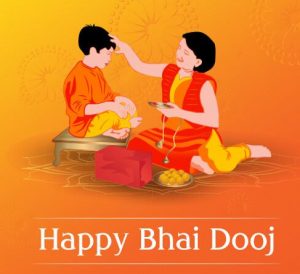Calendar
| Sun | Mon | Tue | Wed | Thu | Fri | Sat |
|---|---|---|---|---|---|---|
| GOVARDHAN PUJA (ANNAKUT) GOVARDHAN PUJA (ANNAKUT) Nov 1 all-day 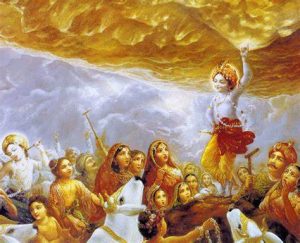 The fourth day of Diwali: Padwa & Govardhan Puja On this day, Govardhan Pooja is performed. Many thousands of years ago, Lord Krishna caused the people of Vraja to perform... | ||||||
| Sunday Bhajan and Satsang 11:30 am Sunday Bhajan and Satsang Nov 3 @ 11:30 am – 1:00 pm 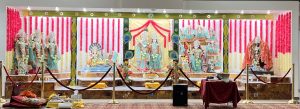 Every Sunday, we have SATSANG (Bhajans, kirtans, Kathas etc.) From 11:30 AM – 01:00 PM followed by Aarti and Prasadam (Lunch) | ||||||
| Sunday Bhajan and Satsang 11:30 am Sunday Bhajan and Satsang Nov 10 @ 11:30 am – 1:00 pm  Every Sunday, we have SATSANG (Bhajans, kirtans, Kathas etc.) From 11:30 AM – 01:00 PM followed by Aarti and Prasadam (Lunch) | ||||||
| TULASI VIVAH TEMPLE CELEBRATION 11:00 am TULASI VIVAH TEMPLE CELEBRATION Nov 17 @ 11:00 am – 2:00 pm 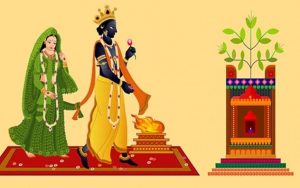 Tulasi Vivah – TEMPLE CELEBRATION ON SUNDAY Tulsi Puja plays a very significant role for Hindus. It is believed that on this day, Lord Vishnu married Goddess Tulsi in the... Sunday Bhajan and Satsang 11:30 am Sunday Bhajan and Satsang Nov 17 @ 11:30 am – 1:00 pm  Every Sunday, we have SATSANG (Bhajans, kirtans, Kathas etc.) From 11:30 AM – 01:00 PM followed by Aarti and Prasadam (Lunch) | DURGA MATA KI CHOWKI 5:00 pm DURGA MATA KI CHOWKI Nov 23 @ 5:00 pm – 10:00 pm 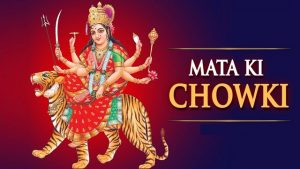 If you would like to host the Mata Ki Chowki at Shree Radhey Shyam Temple, Contact : Raja Sharma 708-822-6656 Maa Durga is revered as the Mother Goddess among the Hindu... | |||||
| Sunday Bhajan and Satsang 11:30 am Sunday Bhajan and Satsang Nov 24 @ 11:30 am – 1:00 pm  Every Sunday, we have SATSANG (Bhajans, kirtans, Kathas etc.) From 11:30 AM – 01:00 PM followed by Aarti and Prasadam (Lunch) |
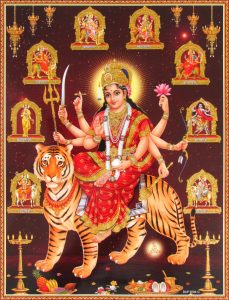
Navratri is a nine days festival dedicated to Goddess Durga. Goddess Durga is worshipped in 9 different forms, known as Navdurga. The tenth day is celebrated as Vijayadashami when idols of Goddess Durga are immersed into the water body.
Navratri is celebrated in most Indian states. However, Navratri is very popular festival in the western states of Gujarat, Maharashtra and the southern state of Karnataka. On the very first day of Navratri, Goddess Durga is invoked into a Kalash with full Vedic rituals along with chanting of Mantras. The invocation and dwelling of Goddess Durga into the Kalash is known as Ghatasthapana or Kalashsthapana and is done at an appropriate time of the day.
In West Bengal Navratri is celebrated as Durga Puja. In West Bengal, Goddess Durga is worshipped on the last three days of Navratri and these three days are famously known as Durga Saptami, Durga Ashtami and Durga Navami. It would be correct to say that Durga Puja in West Bengal is a smaller version of 9 days Navratri. Kalparambha and Bilva Nimantran during Durga Puja, which is done on the sixth day of Navratri, is symbolically same as Ghatasthapana or Kalashsthapana in other states.
Mata Devi Chowki
5.00pm – 6.00pm : Chowki Puja
6.00pm – 10.00pm : Mata Chowki Bhajan and Prasad
All nine forms of Goddess Durga are worshipped during Maha Ashtami Puja.
Young unmarried girls, being treated as Goddess Durga itself, are also worshipped on Maha Ashtami. Worshipping of young girls during Durga Puja is known as Kumari Puja. In many regions Kumari Puja is done during all nine days of Durga Navratri. Kumari Puja on a single day during Durga Puja is preferred on Maha Ashtami.
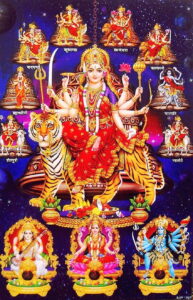
Navaratri Devi Chowki is a special devotional event held during the Navaratri festival, which is dedicated to worshiping the nine forms of the goddess Durga. During this event, devotees gather to sing bhajans (devotional songs), perform aarti (ritual of worship with light), and offer prayers to the goddess. It’s a time of great spiritual significance and celebration.
The nine forms of Goddess Durga, collectively known as Navadurga, are worshipped during the Navaratri festival. Each form represents a different aspect of the goddess and has unique attributes and significance:
- Shailaputri: Known as the “Daughter of the Mountain,” she is the embodiment of the collective power of Brahma, Vishnu, and Shiva. She rides a bull and carries a trident and a lotus.
- Brahmacharini: This form represents penance and austerity. She holds a rosary and a water utensil, symbolizing devotion and wisdom.
- Chandraghanta: Known for her bravery, she has a golden complexion and rides a tiger. She has ten hands, each holding a weapon, and a crescent moon on her forehead.
- Kushmanda: She is believed to be the creator of the universe, bringing light to the dark cosmos. She rides a lion and has eight or ten hands holding various weapons and holy objects.
- Skandamata: The mother of Skanda (Kartikeya), she represents motherhood and nurturing. She rides a lion and holds her son in her lap.
- Katyayani: Born to the sage Katyayana, she is a warrior goddess who rides a lion and has four hands, each holding a weapon.
- Kalaratri: Known as the dark and fierce form of Durga, she destroys ignorance and removes darkness. She rides a donkey and has a dark complexion.
- Mahagauri: Representing purity and serenity, she has a fair complexion and rides a bull. She is often depicted in white clothes.
- Siddhidatri: The goddess of supernatural powers and healing, she sits on a lotus and has four hands. She grants wisdom and insight12.
Each of these forms is celebrated on a different day of Navaratri, with specific rituals and prayers dedicated to them

If you would like to host the Mata Ki Chowki at Shree Radhey Shyam Temple, Contact : Raja Sharma 708-822-6656
Maa Durga is revered as the Mother Goddess among the Hindu Goddesses. Mata Ki Chowki is a short-duration Kirtan that can be done at any time of day, at any time of year. The essence behind performing the Mata Ki Chowki is to fulfil one’s wishes. This Puja ceremony involves the gathering of many worshipers who spend three hours singing hymns in her praise in order to please the Goddess so that she can grant them their wishes. Mata ki chowki includes kirtans and bhajans which are performed in the respect to Mata Durga, Mata Laxmi, Mata Kaali, Saraswati, and Annapurna.
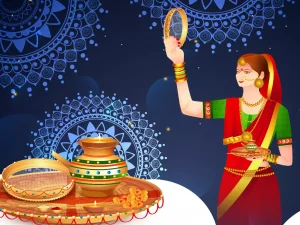
Karwa Chauth coincides with Sankashti Chaturthi a fasting day observed for Lord Ganesha. The fasting of Karwa Chauth and its rituals are observed by married women for the long life of their husband. Married women worship Lord Shiva and His family including Lord Ganesha and break the fast only after sighting and making the offerings to the moon. The fasting of Karwa Chauth is strict and observed without taking any food or even a drop of water after sunrise till the sighting of the moon in the night.
Karwa Chauth day is also known as Karak Chaturthi (करक चतुर्थी). Karwa or Karak refers to the earthen pot through which water offering, known as Argha (अर्घ), is made to the moon. Karwa is very significant during Puja and it is also given as Dan to the Brahmin or any eligible woman.

